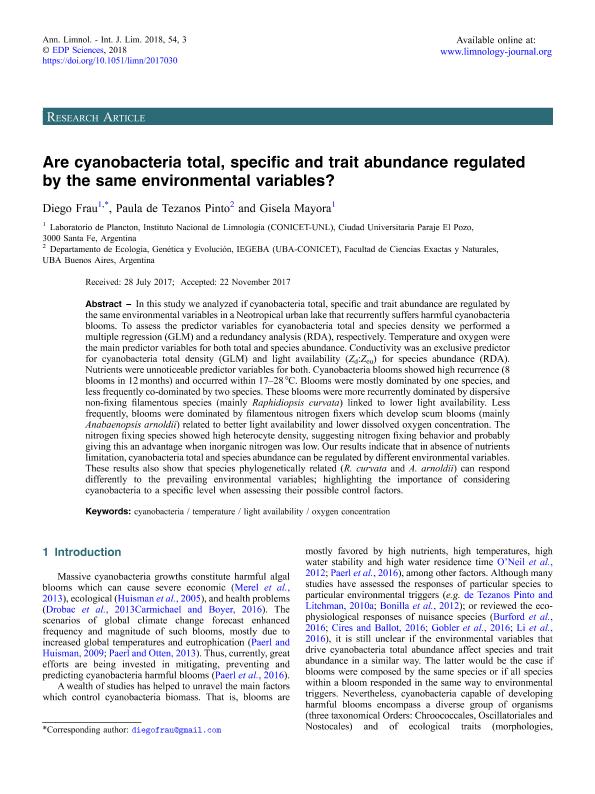Mostrar el registro sencillo del ítem
dc.contributor.author
Frau, Diego

dc.contributor.author
de Tezanos Pinto, Paula

dc.contributor.author
Mayora, Gisela Paola

dc.date.available
2020-02-13T14:05:45Z
dc.date.issued
2018-01
dc.identifier.citation
Frau, Diego; de Tezanos Pinto, Paula; Mayora, Gisela Paola; Are cyanobacteria total, specific and trait abundance regulated by the same environmental variables?; EDP Sciences; International Journal of Limnology; 54; 1-2018; 1-9
dc.identifier.issn
0003-4088
dc.identifier.uri
http://hdl.handle.net/11336/97381
dc.description.abstract
In this study we analyzed if cyanobacteria total, specific and trait abundance are regulated by the same environmental variables in a Neotropical urban lake that recurrently suffers harmful cyanobacteria blooms. To assess the predictor variables for cyanobacteria total and species density we performed a multiple regression (GLM) and a redundancy analysis (RDA), respectively. Temperature and oxygen were the main predictor variables for both total and species abundance. Conductivity was an exclusive predictor for cyanobacteria total density (GLM) and light availability (Zd:Zeu) for species abundance (RDA). Nutrients were unnoticeable predictor variables for both. Cyanobacteria blooms showed high recurrence (8 blooms in 12 months) and occurred within 17-28 °C. Blooms were mostly dominated by one species, and less frequently co-dominated by two species. These blooms were more recurrently dominated by dispersive non-fixing filamentous species (mainly Raphidiopsis curvata) linked to lower light availability. Less frequently, blooms were dominated by filamentous nitrogen fixers which develop scum blooms (mainly Anabaenopsis arnoldii) related to better light availability and lower dissolved oxygen concentration. The nitrogen fixing species showed high heterocyte density, suggesting nitrogen fixing behavior and probably giving this an advantage when inorganic nitrogen was low. Our results indicate that in absence of nutrients limitation, cyanobacteria total and species abundance can be regulated by different environmental variables. These results also show that species phylogenetically related (R. curvata and A. arnoldii) can respond differently to the prevailing environmental variables; highlighting the importance of considering cyanobacteria to a specific level when assessing their possible control factors.
dc.format
application/pdf
dc.language.iso
eng
dc.publisher
EDP Sciences

dc.rights
info:eu-repo/semantics/openAccess
dc.rights.uri
https://creativecommons.org/licenses/by-nc-sa/2.5/ar/
dc.subject
CYANOBACTERIA
dc.subject
LIGHT AVAILABILITY
dc.subject
OXYGEN CONCENTRATION
dc.subject
TEMPERATURE
dc.subject.classification
Ecología

dc.subject.classification
Ciencias Biológicas

dc.subject.classification
CIENCIAS NATURALES Y EXACTAS

dc.title
Are cyanobacteria total, specific and trait abundance regulated by the same environmental variables?
dc.type
info:eu-repo/semantics/article
dc.type
info:ar-repo/semantics/artículo
dc.type
info:eu-repo/semantics/publishedVersion
dc.date.updated
2019-10-18T17:59:58Z
dc.journal.volume
54
dc.journal.pagination
1-9
dc.journal.pais
Francia

dc.journal.ciudad
Paris
dc.description.fil
Fil: Frau, Diego. Consejo Nacional de Investigaciones Científicas y Técnicas. Centro Científico Tecnológico Conicet - Santa Fe. Instituto Nacional de Limnología. Universidad Nacional del Litoral. Instituto Nacional de Limnología; Argentina
dc.description.fil
Fil: de Tezanos Pinto, Paula. Consejo Nacional de Investigaciones Científicas y Técnicas. Oficina de Coordinación Administrativa Ciudad Universitaria. Instituto de Ecología, Genética y Evolución de Buenos Aires. Universidad de Buenos Aires. Facultad de Ciencias Exactas y Naturales. Instituto de Ecología, Genética y Evolución de Buenos Aires; Argentina
dc.description.fil
Fil: Mayora, Gisela Paola. Consejo Nacional de Investigaciones Científicas y Técnicas. Centro Científico Tecnológico Conicet - Santa Fe. Instituto Nacional de Limnología. Universidad Nacional del Litoral. Instituto Nacional de Limnología; Argentina
dc.journal.title
International Journal of Limnology
dc.relation.alternativeid
info:eu-repo/semantics/altIdentifier/url/https://www.limnology-journal.org/10.1051/limn/2017030
dc.relation.alternativeid
info:eu-repo/semantics/altIdentifier/doi/https://doi.org/10.1051/limn/2017030
Archivos asociados
